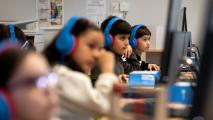Imagine a classroom, gently humming with the activity of learning, where children as young as three and as old as six work together or separately, where they can be found exploring math concepts, poring over maps, or making themselves a snack — or perhaps choosing to do something else entirely.
They are figuring out how to operate independently, resolving their own conflicts, learning to read and write, sometimes as young as three — all in a place designed to provide freedom with structure, to channel energy towards learning with the freedom to learn but also enough structure to ensure they learn well.
It is an environment geared towards their development, right down to the furniture, filled with educational materials and a teacher to inspire their curiosity and help them understand this learning environment and encourage them to explore it.
That’s the vision Higher Ground vice president of pedagogy Matt Bateman shared in a podcast interview.
Higher Ground, the county’s largest private operator of Montessori schools and with over 100 around the world, believes they have found a new way forward for education, a “third way” which balances academic rigor with the freedom for kids to still explore their individuality and pursue education with agency.
“Incremental changes are going to be insufficient,” says Laura Mazer, Higher Ground senior vice president of programs. “Higher Ground’s mission is to redesign education from the ground up.”
A third way
To build a new education system, you need four things, says Higher Ground CEO Ray Girn: curriculum, teachers to teach it, systems to help it run, and the real estate to host students.
“And Higher Ground Education is doing something radical in each of those four areas,” Girn says.
When it comes to pedagogy — the methods and practices of teaching — parents today are usually offered a binary choice, Mazer says.
On one hand, there are the traditional schools that put the focus on academic rigor, at the expense of being able to optimize learning for the unique needs of every student. On the other, there are progressive schools, where children can jump from project to project pursuing their own interests, but there are few clearly defined guideposts.
But parents do not need to accept that the tradeoffs between a vocational education and a liberal arts education are inevitable — there can be more than two options.
“Our schools are the third option,” Mazer says. “They are the marriage of rigor and individualization that lets students thrive because they are given the structure that enables them to do so.”
“Montessori is like poetry… If you do it, you have to do it well, or it will fall flat on its face.”
Ray Girn
The school environments are designed to be both functional and beautiful, Mazer says, and they are built so that they can flex to the needs of the lessons, rather than trying to force lessons to fit into the more rigidly structured environments of traditional schools.
If students decide to work in small groups, their classrooms are conducive to that; if they would prefer to work alone, they can do that too.
As students move into middle and high school, their education becomes more interdisciplinary. They have more choice in what interests they wish to pursue, and how to demonstrate their mastery of certain objectives — a microcosm for the blending of independence and structure that marks Higher Ground’s third way.
A curriculum needs teachers, however.
“Montessori is like poetry,” Girn told the podcast. “If you do it, you have to do it well, or it will fall flat on its face. In order to do Montessori well, you have to develop a different type of educator who is oriented to education in a different way.”
Staff training has been a focus for Higher Ground from the beginning. The Prepared Montessorian Institute is Higher Ground’s accredited training institute and professional development platform. Educators can take single-session lessons to learn how to apply Montessori principles, become certified lead guides, and continue their professional development.
Bringing education to as many children around the world as possible requires a place for those children to learn, too. Higher Ground has a real estate team devoted to developing more brick and mortar schools, with in-house expertise in choosing a site, construction, and setting up the actual school.
Through these programs, they’ve become the largest private operator of Montessori schools in the U.S.
“Higher Ground is doing something radical…”
Ray Girn
Because of the flexibility of the education system, a variety of buildings could make for potential schools, and operators of other schools or child care centers can work with Higher Ground to turn their building into a modern Montessori school.
Higher Ground, operating under the brands Guidepost Montessori and the Academy of Thought & Industry, has designed a curriculum that fosters development and independence – one that builds the foundation of knowledge and character needed to live a thriving and successful life.
A new system for a new student
Childhood development and education requires approaches that are complex, multi-faceted, and holistic — the curriculum, the students, the teachers to guide them, and the classrooms they can learn and grow in.
“We full on embrace the kind of challenge of doing everything, and really attacking the problem at a systems level,” Girn says.
Higher Ground has reached around 10,000 students in five years, Girn says — why not 10 million in the next five?
The students of the future will have a deep capacity for work, Girn says; they will have an insatiable sense of curiosity, and a deep love for humanity and sense of wonder, fostered by a new approach to education.
“We are motivated by the goal of bringing this approach to every child, globally, that we can,” Girn says. To learn more about how Higher Ground is unlocking the full potential of every child, visit Guidepost Montessori and Academy of Thought and Industry.






